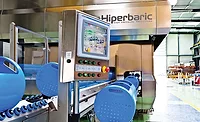Non-traditional pet food: some alternatives

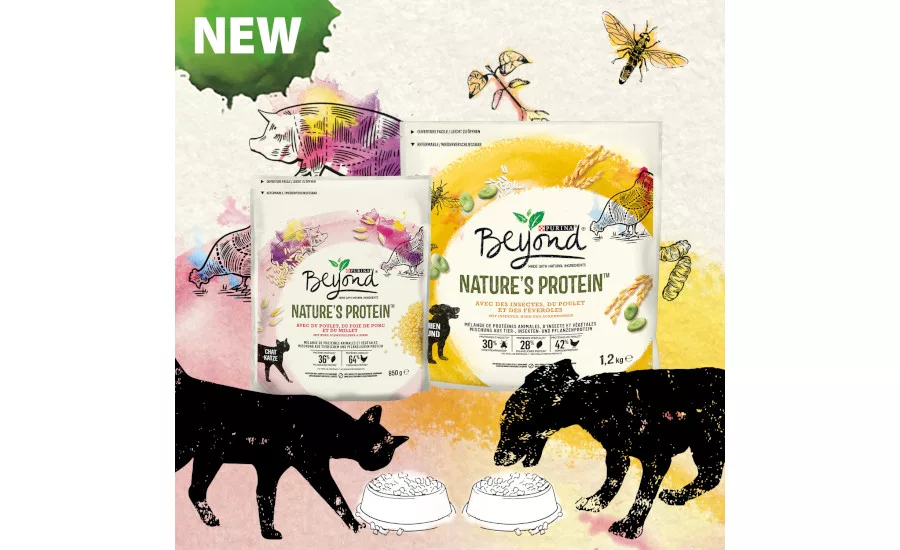
Veterinarians and nutritionists at Purina put together two dry food recipes for Beyond Nature’s Protein brand: one based on chicken, pig’s liver and millet; the second using insect protein, chicken and fava beans. Photo courtesy Purina

Shannon Falconer cultures meat in the lab at Because Animals. The novel pet food company wanted to create a healthier, safer, more environmentally friendly way to feed pets, so they used their combined expertise in science and business to create cultured meat for pet food and founded Because Animals. Photo courtesy of Because Animals
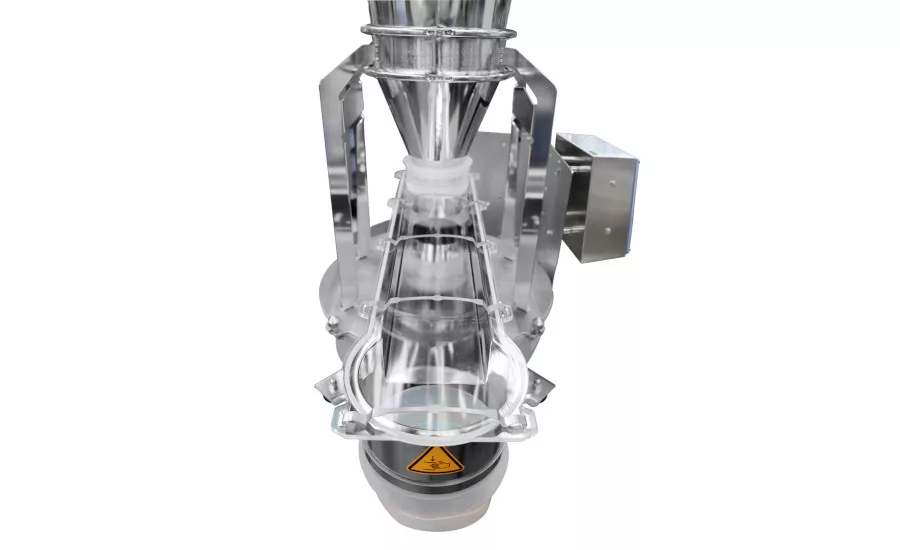
Coperion K-Tron’s V200 vibratory feeders are suitable for the gentle handling of bulk materials, including pet food. Photos courtesy Coperion, Salinas, Kan.
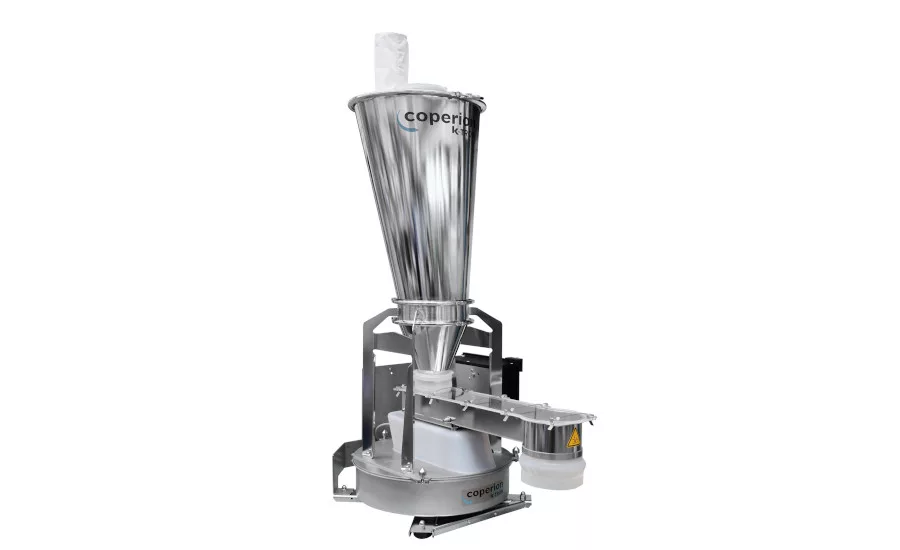
Coperion K-Tron’s V200 vibratory feeders are suitable for the gentle handling of bulk materials, including pet food. Photos courtesy Coperion, Salinas, Kan.

Coperion twin screw ZSK extruder offers a hygienic design and is suitable for processing non-traditional pet food. Photo courtesy Coperion, Stuttgart, Germany
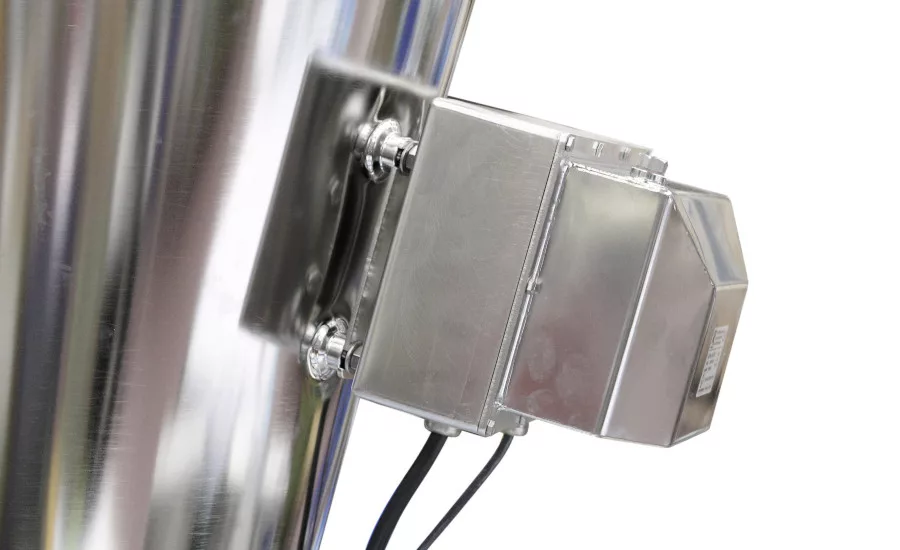
Coperion K-Tron ActiFlow smart bulk solid activator is designed to prevent bridge-building of cohesive bulk materials. Photo courtesy Coperion, Salina, Kan.

A TOMRA sorter is used at J.G. Pears to keep foreign materials out of the raw materials they supply to pet food processors. Photo courtesy TOMRA Food
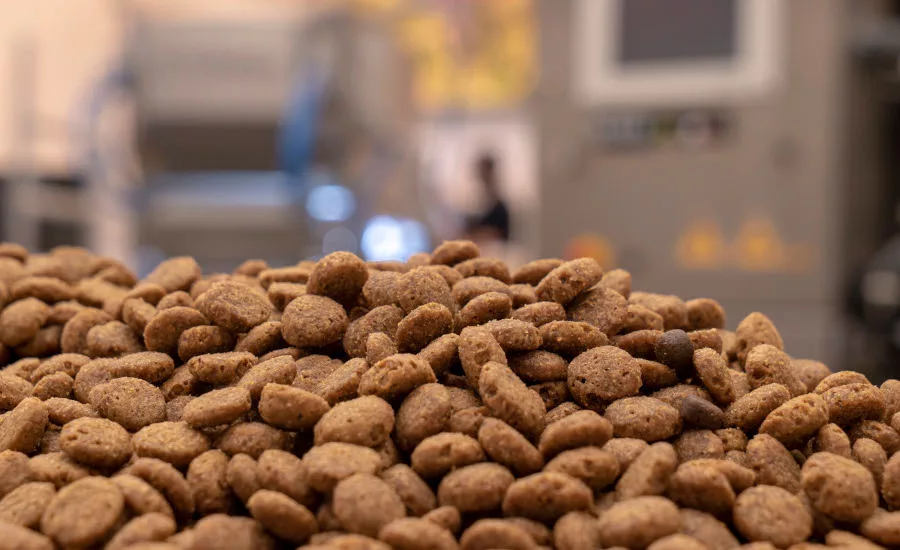
Pet food kibbles are kept free of foreign material and cross-contamination with the use of a TOMRA sorter. Photos courtesy TOMRA Food
As seen in Food Engineering’s February cover story, “The Rise of Alternative Protein,” the alternative protein market continues to grow. Because pet food trends tend to follow human food trends—much like a puppy or kitten follows its owner—it makes sense that what we feed our pets mirrors what we consume.
Whether Fido’s food is made from all plant-based ingredients, a flexitarian’s mix of plant- and animal-derived ingredients, insect-based or with lab-grown meat, processors and those who supply the equipment to make non-traditional pet food have their work cut out for them.
Take Switzerland’s Purina Beyond Nature’s Protein brand, for instance. Veterinarians and nutritionists at Purina put together two dry food recipes: one based on chicken, pig’s liver and millet; the second using insect protein, chicken and fava beans. Available for dogs and cats, both recipes hit Switzerland’s retail market in November 2020.
“Every ingredient in our food serves a purpose,” a Purina spokesperson says. “With our new Beyond Nature’s Protein dry pet food, we are offering a complete nutritious alternative to conventional dog and cat products, while diversifying the protein sources.”
Purina says the demand for products made with alternative proteins continues to grow in many food categories, including pet food. This trend is true for insect-based pet food too, which is smaller compared to other sources of proteins like plant-based ones. Purina notes it is also important to consider that pet owners recognize that their pets have a different taste and needs from themselves and therefore insects may be considered as a more appealing solution for their cats and dogs’ enjoyment, compared to other source of proteins.
Insects, like animal- and plant-based proteins, are good sources of protein, and it is important to blend them to ensure that the product delivers all essential amino acids dogs and cats need. The company says its cat and dog recipes use a combination of protein sources to meet the nutritional needs of different pets.
A couple months after the launch of Beyond Nature’s Protein, the company says it is satisfied with the performance of the range, which was in line with their expectations. They say consumer acceptance is promising. “From a consumer research perspective, we carried out some research in December 2020, and found that 83% of the Swiss consumers who tried the range confirmed their pet liked the product and 75% of them would repurchase the product,” the Purina spokesperson says. The research was conducted among 1,700 Swiss consumers in December 2020.
Although Purina is not able to share all the details about how this brand is made, they did share a general explanation about their dry pet food production process here (see www.purina.co.uk/your-questions-matter/how-it-is-made/dry-pet-food-production).
Dry and wet food processing
When it comes to processing plant-based protein in particular, it’s important to note the differences in the extruded products that are often used in pet food, says Sharon Nowak, business development manager, Coperion K-Tron USA. The dry process makes dry texturized vegetable protein (TVP) products used as meat extenders and vegetarian meat substitutes. The wet process makes high-moisture meat analogues (HMMA) with the characteristics of animal meat. There are different processes for each in terms of equipment/lines, process, raw material and processing environment.
Nowak notes that TVP is used both as a meat analogue or vegan meat and as a supplement to meat products. It can be produced in various sizes and forms, as smaller pellets or larger chunks, broken down or ground. TVP is a dry, expanded product with a long shelf life under normal ambient conditions and requires rehydration in water or liquid before use.
HMMA is primarily used as a high-quality meat-analogue product. By adjusting recipe and process parameters, structures of different meat types can be replicated with striking similarity to the original, Nowak says.
Dave Carney, market segment leader at Bühler Aeroglide notes there is a big difference in food safety and handling of the finished products. “Dry pet food kibbles are considered as low moisture foods; wet products are high-moisture foods. This is taken into account in every step of the process and plant design.”
Pet food safety
Processors must be cognizant of what consumers expect—even demand—at all times. “The pet food customer today demand the highest quality product and hold a zero-tolerance policy when it comes to foreign material,” says Lars Povlsen, global sales manager, proteins, at TOMRA Sorting GmbH. “Rubber, plastics, wood and even glass simply do not belong in premium pet food, and an in-line optical sorter ensures a safe and superior product. Investing in optical sorting showcases a pet food processor’s willingness to tackle industry challenges like foreign material and cross contamination through innovative technology. Processors that implement optical sorting will undoubtedly increase their market share by differentiating themselves from other suppliers.”
Craig Harrison, site manager at J.G. Pears, a processor of the raw materials for pet food, says the company is delighted with the sorters they installed. “Non-conformances with our customers have reduced dramatically and regarding the TOMRAs, we see very, very little waste and foreign bodies in our material. The current customers already have seen the difference in the finished product, and we're also having lots of interest from additional customers asking and enquiring about buying our material.”
Vicky Prussia, customer relations manager at JG Pears, adds, “After we'd installed TOMRA, we started to look at some of the things that the machine was taking out of our process, and some of the things that we saw were things like plastics, wood, rubber. Just having the TOMRA machines in the factory, we can see now that we are removing more of the foreign bodies.”
Tom Barber, vice president at Bühler Aeroglide, adds that Bühler can assist pet food processors in determining processing parameters for the equipment and formulas incorporating the alternative proteins and non-traditional pet food. “We can do this in our global network of labs and process technology centers that have pilot plants. We can determine the relationship between product formulation, extruder screw configuration and operating conditions, and dryer operating parameters to achieve the desired final product. This would be the same as we do for customers making traditional pet food or pet treats. For truly novel, startup companies with unique product ideas, Bühler has our CUBIC innovation center in Uzwil, Switzerland, for collaboration and development between industry, academia and Bühler specialists,” he says.
Making meat
Speaking of startups with unique product ideas, take a look at the cultured meat segment. Funding for these types of companies was up 266% in 2020, according to FutureBridge, a company that tracks and advises enterprises on the future of industries from a 1- to 25-year perspective.
In the last decade, dozens of startups have sought to make cell-cultured meat both tasty and affordable with the end goal of persuading consumers to turn their backs on conventional meat.
“We are now witnessing cultured meat products move from the lab to the factory,” says Sarah Browner, senior analyst at FutureBridge. “Many cultured meat companies believe they will have commercial products ready within the next few years. However, they caution that it is more important to get the release right than to do it quickly.”
Of course, this data is specific to culturing meat for human consumption. As if on cue, here comes that kitten on its human’s heels. Look at Because Animals, a novel pet food company that began at a cat rescue. Shannon Falconer and her business partner, Joshua Errett, were volunteering to help get stray and feral cats off the street. They wanted to create a healthier, safer, more environmentally friendly way to feed pets, so they used their combined expertise in science and business to create cultured meat for pet food and founded Because Animals.
Falconer notes they are still developing cultured meat, but the process to produce their pet food will be completely vertical. “We can harvest the meat and prepare the food on the same production floor,” she says.
Several people in the industry shared their insights on pet food production and the current role of alternative proteins. Q&As can be found by clicking on the links below. All Q&As have been edited for style, length and clarity.
 Shannon Falconer is CEO of Because Animals, a pet food startup that cultures meat. She has a PhD in biochemistry and worked as a researcher at Stanford University before this endeavor.
Shannon Falconer is CEO of Because Animals, a pet food startup that cultures meat. She has a PhD in biochemistry and worked as a researcher at Stanford University before this endeavor.
Sharon Spielman, Food Engineering (SS): Tell me briefly how Because Animals got its start. Why this niche?
Shannon Falconer (SF): It started, appropriately, at a cat rescue. Both my business partner, Joshua Errett, and I were volunteering to help get stray and feral cats off the street. The irony of helping one animal while being forced to feed them food resulting in the suffering of not only other animals but also the planet as a whole, was not lost on us. Commercial pet food is made with something referred to as 4D meat, which comes from animals that are dead, diseased, dying and disabled. Pet food is made from meat that is unfit for human consumption. I have a PhD in biochemistry and when we met I was working as a researcher at Stanford University and Josh was just finishing his MBA. With our combined expertise in science and business we knew we could create a healthier, safer, more environmentally friendly way to feed our pets, and that’s when we decided to create cultured meat for pet food and we founded Because Animals.
We don’t see it as niche at all! Rather, we see it as thinking ahead. The way we currently produce meat, with environmentally disastrous and inefficient concentrated animal feeding operations (a.k.a. factory farms) is unsustainable. There will come a time when that method of meat production will no longer exist—we simply won’t have the resources for it. We have to find alternatives, and with the rapid onset of global warming, such alternatives can’t come soon enough.
SS: Can you tell me how your products differ from traditional pet food?
SF: We are not making a meat alternative, we are making meat—the alternative is the way that meat is produced.
In creating cultured meat, we collect a small sample of cells from an animal and then grow those cells in a nutrient-rich environment until they grow, and grow and grow until there are enough animal cells—which, collectively, are otherwise known as meat!—that we then add to our food. The process of growing our meat is very similar to the production of beer or yogurt, where yeast (beer) or probiotic (yogurt) cells are grown inside a large vat, surrounded by vitamins, minerals and amino acids—all of the nutrients that are essential for cells regardless of whether they’re grown inside or outside of an animal. With our process, we don’t need vast acres of land, gallons of water, or antibiotics, hormones or fossil fuels to raise, feed and slaughter animals. The process of culturing meat—which is a much safer, sustainable way to produce meat that also stands to be healthier for our pets—is actually very similar to a food production process that has been used by humans for thousands and thousands of years.
We currently sell probiotic-based supplements, which we call Omega & Probiotic Sprinkles, for each cats and dogs. We also have a line of organic dog cookies made from nutritional yeast, called Noochies. We offer a peanut butter-flavored cookie as well as a pumpkin maple syrup-flavored cookie with added beta glucan from yeast, which helps combat inflammation and boost overall immunity. Both our supplements and cookies are made with cultured ingredients that are incredibly healthy for pets.
SS: Please tell me about how your pet food is manufactured.
SF: We are still developing our cultured meat, but the process to produce pet food with our meat will be completely vertical—we can harvest the meat and prepare the food on the same production floor.
SS: What are your greatest engineering challenges when producing your products? How do you overcome them?
SF: Culturing meat for large-scale commercialization is a significant engineering challenge. Not because culturing the meat itself is difficult—indeed, researchers have been growing tissue in a lab for many decades—but because it’s very difficult to do at a price point and yield that is commercially viable. As such, we need to create customized equipment that permits us to grow and harvest our cells at the scale and cost that will be accepted by customers. But we’re a team of engineers, biochemists and tissue scientists who love solving complex problems, so our science team members are definitely in their element!
SS: What trends do you see in this market?
SF: We’ve seen a boom in plant-based foods for dogs. We totally support these companies—they have many of the same sustainability goals as Because Animals. But we are doing something different: Specifically, rather than creating a plant-based meat alternative for our pets, we are creating meat—with the difference being our production method, which is more environmentally sustainable and humane. We want our cats and dogs to eat meat, but we want them to eat meat that is produced responsibly and safely. At the moment, that product doesn’t exist but it will soon, so keep your eye out for Because Animals.
SS: What emerging technologies do you see in food manufacturing in general as well as specifically for this alternative pet food market?
SF: Where we see both plant-based products and cultured meat as the future for human food, we absolutely see cultured meat—and only cultured meat—as the future for pet parents wanting to feed their cat or dog a truly sustainable, humane, nutritious and safe pet food.
SS: Anything else you would like to add?
SF:Although there are a handful of other companies creating pet foods made with meat alternatives, Because Animals is currently the only company creating cultured meat for cats and dogs. We are excited to welcome new entrants to the cultured meat pet food category when they emerge, but we are also very proud to be trailblazers and the world’s first cultured meat pet food company.
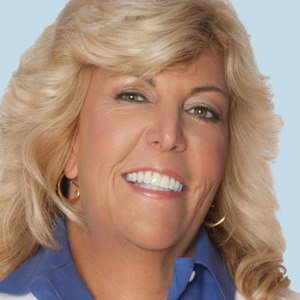 Sharon Nowak is business development manager at Coperion K-Tron USA. The company is a global supplier of feeders, pneumatic conveying components and complete material handling systems, including systems engineering and a global network of field service engineers, parts and training services.
Sharon Nowak is business development manager at Coperion K-Tron USA. The company is a global supplier of feeders, pneumatic conveying components and complete material handling systems, including systems engineering and a global network of field service engineers, parts and training services.
Sharon Spielman, Food Engineering (SS): How is Coperion involved in the processing of non-traditional pet food (i.e., that made with plant-based protein and/or CBD additives, or other non-traditional pet foods)?
Sharon Nowak, Coperion K-Tron USA (SN):Coperion is the international market and technology leader for extrusion systems, feeding technology, bulk material handling systems and services. Coperion designs, develops, manufactures and maintains systems, machines and components for the pet food, food, pharmaceutical and nutraceutical industries.
Because of direct requests from our pet food customers, Coperion has introduced several innovations to our extrusion process product line, which can include all the material handling and conveying of the raw ingredients prior to the mixing step, as well as the extrusion step. Many of these innovations include handling specifically of plant-based proteins as well as CBD additives.
Before we discuss the equipment innovations for PBP, it is important to note the differences in the extruded PBP products, which are often used in pet food productions.
TVP is used both as a meat analogue or vegan meat and as a supplement to meat products. It can be produced in various sizes and forms, as smaller pellets or larger chunks, broken down or ground. TVP is a dry, expanded product with a long shelf life under normal ambient conditions. TVP requires rehydration in water/liquid before use.
When manufacturing TVP, the extruder’s main inlet is continually fed with bulk raw protein material using Coperion K-Tron’s high accuracy loss-in-weight feeders and material handling refill systems. Immediately thereafter, water is injected using Coperion K-Tron liquid feeders. In certain cases, direct steam injection is applied into the process section as well. Within the process section, materials are mixed, kneaded and cooked. The product then moves out of the extruder via a nozzle plate where it is processed such that it achieves a porous, foamy structure with oriented fibers. Coperion ZGF pelletizer’s knife rotor then immediately cuts the product. The TVP granules are then dried to ensure long-term product stability.
Alternatively, HMMA is primarily used as a high-quality meat-analogue product. By adjusting recipe and process parameters, structures of different meat types can be replicated with striking similarity to the original. HMMA’s moisture content lies between approximately 50-80% and must therefore be refrigerated. Protein sources used to manufacture high-quality HMMA are primarily legumes such as soy, lupine or pea. In certain cases, i.e., when manufacturing meat product extenders, lesser quantities of genuine meat or fish products are added.
For the HMMA process, the bulk raw protein material is fed into the extruder inlet. Water is then added. Within the ZSK Food Extruder’s process section, this mass is then fully mixed and kneaded. Discharge takes place using a cooling die that generates a meat-like texture which is “frozen in.” The result is a solid strand with fiber structure similar to meat; the strand is then conveyed to the next process step.
(Watch a video of how Coperion has produced HMMA on ZSK extruder in their test lab.)
As stated above, in order to address this growing market, not only in pet food but for human food consumption, Coperion has developed several innovations, including:
- Improvements in cooling die technologies, particularly for the high-moisture texturized proteins used in wet and canned pet food products. For example, Coperion has a long-standing relationship with the German Institute of Food Technologies in the development of these technologies for food extrusion. Within this process, the moisture content exceeds 50%, up to 70% in individual cases, which is comparable with the moisture content of lean meat. This high-moisture extrusion cooking process can be used for the production of meat substitutes featuring desirable sensory properties from raw plant materials with high protein content such as wheat, soy, pea and lupine flours protein concentrate. Decisive factors that have been studied through the Coperion/DIL collaboration have resulted in larger scale production size extruders designed specifically for the process of protein denaturation in the extruder, and the control of the downstream cooling and fibrillation in the special cooling die.
- Improvements in method of feed and feeder technologies of raw ingredients to the extruder. These improvements focus specifically on difficult to feed ingredients, such as many plant based protein powders, which may be very light in bulk density, or cohesive with capabilities to cause bridging in the feeder hopper. For difficult flowing products, the introduction of the Coperion K-Tron ActiFlowTM has been extremely beneficial. This real time vibration device is mounted external to the feeder (with no product contact), but is tied directly into the loss-in-weight signal. If the feeder experiences a bridge or rat-hole and little or no material is being sent to the screws, the ActiFlow vibration is activated and the bridge breaks. After the weight signal is stable again, the vibration is deactivated, preventing additional packing that may sometimes occur with traditional vibration devices. In other words, it is a “smart” real-time vibration device activated clearly by the loss-in-weight signal.
- Dual hybrid design extruder to process both HMMA and TVP in the same extruder. The Coperion Hybrid Design ZSK extruder allows the end-user to develop and manufacture both TVP and HMMA on the same machine with only a minimum amount of retrofitting. The feeding and process section for both applications are nearly identical, while the discharge units differ significantly. While the aforementioned ZGF Centric Pelletizer is attached to the process section for manufacturing TVP in order to cut the product directly at the nozzle plate, HMMA is discharged using the previously discussed specialized cooling nozzle, which produces a product strand that exhibits a texture closely resembling that of genuine meat. Using an adapter solution developed by Coperion, the ZSK Extruder’s discharge can now be switched from a pelletizer to a cooling nozzle in no time. The same principle functions just as quickly in reverse when switching from an HMMA process to TVP.
- Addition of CBD to the Pet Food Extrusion Process. In addition to the TVP and HMMA processes above, as an alternative, incorporating CBD or other oils into the extruded pet food has also been demonstrated. The twin screw extruder’s combination of self-wiping screw design and modular construction allows it to add 10% or more to the extruded product or kibble.
SS: What differences might processors face when making non-traditional pet food vs. traditional?
SN:In addition, there is also a trend of more natural pet foods, which may include ingredients such as vegetables—e.g., peas, carrots, sweet potatoes, etc. It is important that these ingredients, also known as “inclusions,” be metered into the mixing processes without destroying their shape, texture or composition. Coperion K-Tron’s new loss-in-weight vibratory feeder has proven to be ideal for the highly accurate feeding of these fragile inclusions direct to the process without damage to the product. The innovative patent-pending technology of the new vibratory drive ensures that an accurate mass flow is maintained, without any attrition which may be caused by other means of feeding such as screw feeders. In addition the new vibratory tray design includes a modular quick change feature, ideal for optimizing product changeover as well as cleanability.
SS: What engineering challenges in particular do you see your customers facing when they enter this market space? How are these overcome?
SN:As discussed above, one of the major issues with handling the plant proteins is their cohesive and difficult flowing nature. This can present significant engineering hurdles when designing systems to both convey the powder to the mixer or extruder, and also when feeding the material accurately into the extruder. In addition to the use of the ActiFlow device mentioned above, the internal components of the screw feeder need to be designed to avoid surges, thus twin screws are preferable. For handling the material upstream via pneumatic convey methods, a number of design principles should be adhered to in order to minimize any buildup or flow issues in the transfer and convey lines, such a minimized number of elbows, optimization of the convey tubing and optimized designs of the pickup points and pneumatic receivers, such as the use of aerated hoppers or special easy clean filter assemblies. Finally, the extruder screw design in the feed section needs to be of special design that is not typical for hard to feed materials. In the case of HMMA cooling dies, coatings and liners are very influential in product quality. It is important to note that extruder parameters need adjustment for every new formulation.
 Lars Povlsen (LP) is global sales manager, proteins, at TOMRA Food. The company makes sensor-based sorting machines for the food industry as well as provides advanced sorting solutions for pet food producers.
Lars Povlsen (LP) is global sales manager, proteins, at TOMRA Food. The company makes sensor-based sorting machines for the food industry as well as provides advanced sorting solutions for pet food producers.
Sharon Spielman, Food Engineering (SS): When it comes to non-traditional pet food, why is the type of equipment that TOMRA supplies important?
LP:Looking at the trend with plant-based pet food, you will have the same challenges as for conventional both for foreign material (FM) and for avoiding mixing different recipes.
SS: What engineering challenges in particular do you see your pet food manufacturing customers face? How are these overcome?
LP:Seeing pet food manufactures facing the same challenges as food suppliers and the need to comply with Food Safety Regulations calls for change management in the way pet food is produced and packed. Just sticking to conventional detection methods avoiding FM can lead to expensive recalls and a damaged brand if a piece of plastic or a wrong kibble ends up in the final pack.
In a highly competitive market where negative publicity shared on social media can irreparably damage a processor’s reputation, removing undesired material from pet food through optical sorting increases customer satisfaction, maintains brand loyalty and protects a processor’s brand.
SS: Do the engineering challenges change depending on whether the product is wet or dry?
LP:The most serious customer complaints and product recalls come from the presence of foreign material in wet pet food or dry kibbles. Whereas the place to sort may be different from wet to dry, the technology stays the same. As the major part of the FM comes in with raw material, the manufacturer will also distinct between sorting it in-house, which works the best for frozen material, or let their suppliers sort if the raw will be dry (bone or poultry meal).
SS: Can you offer an example or two of how TOMRA has helped a pet food processor implement a hygienic design, avoid cross-contamination, etc.?
LP:Investing in optical sorting showcases a pet food processor’s willingness to tackle industry challenges like foreign material and cross-contamination through innovative technology. Processors that implement optical sorting will undoubtedly increase their market share by differentiating themselves from other suppliers.
The pet food customers today demand the highest quality product and hold a zero-tolerance policy when it comes to foreign material. Rubber, plastics, wood and even glass simply do not belong in premium pet food and an in-line optical sorter ensures a safe and superior product.
Two of the leading companies in their segment in UK shows both seeing a clear advantage going this way. J.G. Pears is a leading processor of animal by-products and food waste, and GA Pet Food Partners is one the finest private-label dry pet food manufacturers. The one producing the raw material for the pet food manufactures, and the other producing more than 900 different recipes/kibbles packed in more than 3,000 different packages. Both choosing the solutions from TOMRA not only for securing their brand against complains and recalls, but even more being able to produce a first-class product. This has for both given a clear competitive advantage and been an opener for new customers and markets.
SS: What else should I know as I write this article about the engineering challenges that processors might face during pet food production?
LP:Rendering (animal by-product) turned into either bone or poultry meal used as raw protein material for pet food, aqua feed etc. As this will typically be the CAT3 products coming from abattoirs containing a diversity of FM, which could be everything from earplugs, gloves, plug fingers and so on. As there today is no really good solution getting this sorted before it ends up as meal, we do it before it leaves the processing plants taking out the smallest fragments being rubber, stones, glass, plastic, you name it. At the same, our technology can help enhance the quality of the final product by “boosting” the protein level. Better quality better money.
Pet food (kibbles). Avoiding cross-contamination is a must if you want to supply a high-class product and especially if you produce for APAC. The Japanese customer tends to handfeed to secure no false kibble is passed…. This not only secures you a clear competitive advantage but also save time and money. The typical way of avoiding cross-contamination today is dumping the first several hundred kilos changing from one recipe to another. This both costs product and time, which if you start to calculate makes the payback calculation easy. And looking at the ongoing case with Aflatoxin, we also here would have a solution avoiding this.
 Tom Barber is vice president at Bühler Aeroglide. Barber’s team provides process engineering expertise and support to Bühler’s global capital and customer service sales force. Dave Carney is market segment leader at Bühler Aeroglide, manufacturer of conveyor dryers, roasters, toasters and expanders.
Tom Barber is vice president at Bühler Aeroglide. Barber’s team provides process engineering expertise and support to Bühler’s global capital and customer service sales force. Dave Carney is market segment leader at Bühler Aeroglide, manufacturer of conveyor dryers, roasters, toasters and expanders.
Sharon Spielman, Food Engineering (SS): Tell me how Bühler Aeroglide is involved in the processing of non-traditional pet food.
Tom Barber, Bühler Aeroglide (TB): In the manufacture of dry pet food, Bühler has existing customers making pet food using protein from sources other than animal-based. The plant-based proteins are typically presented as dry, concentrated extracts or isolates. These dry materials are handled throughout the entire process as any other dry ingredient in the pet food formulation.
SS: How does Bühler help processors produce non-traditional pet food?
TB: Bühler can assist pet food processors in determining processing parameters for the equipment and formulas incorporating the alternative proteins and non-traditional pet food. We can do this in our global network of labs and process technology centers that have pilot plants. We can determine the relationship between product formulation, extruder screw configuration and operating conditions, and dryer operating parameters to achieve the desired final product. This would be the same as we do for customers making traditional pet food or pet treats. For truly novel, startup companies with unique product ideas, Bühler has our CUBIC innovation center in Uzwil, Switzerland, for collaboration and development between industry, academia and Bühler specialists.
SS: What engineering challenges do you see your customers facing when they enter this market space? How are these overcome?
TB: Customers conduct trials at our product innovation centers where we develop product trial plans to support them, and many are progressing in a strong innovation phase. We are seeing increased interest in trials using insects, tree nuts and edible seeds, and fungal, yeasts, fermented proteins and other novel ingredients. Novel ingredients mean that not all functional properties are well known or understood, which requires more effort in trials and product development. Trial plans are adjusted as results occur, to define reliable and adaptive processes that protect the integrity of the sensitive ingredients and can be scaled up for production.
SS: Do the engineering challenges change depending on whether the product is wet or dry?
TB: There is a big difference in food safety and handling of the finished products. Dry pet food kibbles are considered as low-moisture foods; wet products are high-moisture foods. This is taken into account in every step of the process and plant design.
SS: Can you offer an example or two of how Bühler has helped a non-traditional pet food processor produce food for our furry friends?
TB: One of the leading pet food processors in Chile took an initiative to replace meat-based protein with plant-based protein in an existing, well-established product. While the product had the same appearance, it had different drying characteristics. Initially, when line capacity and product quality issues arose, it was not clear what caused these differences. Upon closer examination, we determined that the only change was in the ingredient formulation utilizing plant-based protein. By sending portable lab drying equipment and technologists to the customer site, we were able to conduct extensive drying trials to determine optimum operating conditions for the new product formulation.
Looking for a reprint of this article?
From high-res PDFs to custom plaques, order your copy today!






